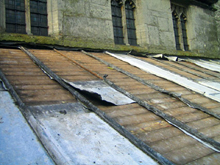English Heritage Publishes New Guidance on Theft of Metal from Churches

English Heritage has today (26 September 2011) issued new guidance on the theft of metal from church buildings in view of the intensification of the problem in some parts of England. The guidance offers greater clarity on when alternative materials might be appropriate and which ones are likely to be considered following theft of roofing materials.
While the guidance continues to advocate like-for-like replacement as the ideal repair approach for church roofs, it states that “English Heritage will consider supporting the replacement of stolen lead with an alternative material after one incidence of theft if it is satisfied that security measures are unlikely to prevent further attacks, and if the proposed alternative material is suitable in terms of technical performance and appearance.”
The guidance goes on to say: “Every case is assessed on its merits but we appreciate that there will be instances when a change of material will be appropriate. After a theft, in some situations, a durable replacement such as terne coated stainless steel or tiles, might be the most prudent way to repair the building. In some circumstances temporary coverings may be necessary whilst a longer-term solution is identified and funded, but support for the use of plastic or other non-traditional materials in listed places of worship would be exceptional.”
Diana Evans, Head of Places of Worship Advice at English Heritage, said: “Many congregations are frustrated and struggling in the aftermath of repeated thefts. We are very concerned about the damage to important buildings, the cost of repairing each one and the additional work inflicted on those who care for historic places of worship. The guidance aims to give as much pragmatic advice as possible to help prevent the ultimate loss of our much loved heritage and suggest how to determine the best way forward after an attack.”
Anne Sloman, Chair of the Church Buildings Council, said: “We are delighted that English Heritage has revised their advice on the replacement of lead roofs on churches which have suffered from repeated thefts. The Church Buildings Council has been campaigning for some time for the government to take action to legislate for tighter regulation of scrap metal yards, but in the meantime we do not think it is sensible to force parishes to replace lead with lead when it is likely to be stolen again within a few weeks.”
Anne Sloman continued: “We share English Heritage's concern to preserve the heritage quality of church buildings, but in this instance we decided some time ago that in the face of the devastating crime wave which is hitting church buildings, alternatives were acceptable and we made our own research on these available to parishes earlier this year."
In offering advice to congregations English Heritage will try to balance the ideal, which means like-for-like replacement to maintain the significance of a building, and the pragmatic, which recognises another material may be more likely to secure the building so that it can continue in use. If changes are to be made local authorities and denominational bodies will need to be convinced that the harm done to the significance of the building will be outweighed by the good done in ensuring its long-term wind and water-tightness.
To help anxious congregations understand the comments English Heritage makes when they put in proposals for replacement roofs, the guidance covers the general issues English Heritage are likely to raise and the advice likely to be offered. The guidance also lists the information churches need to supply to English Heritage so as to avoid delays in securing the necessary permissions.
The guidance highlights the importance of preventing lead theft and the need to use a combination of security measures. Many of the options suggested are simple and inexpensive measures like keeping wheelie bins secure that could be climbed on, or removing water butts near the building, blocking vehicular access, applying anti-climb paint to drain pipes and roof guttering, and erecting prominent warning signs. Marking techniques that help to trace and identify the thieves and the stolen goods, as well as electrical security systems should also be considered.
The guidance also states that metal replacement, whether as part of planned repairs or because of a theft, should be accompanied by the installation of an appropriate security system, ideally before the new roof is laid down so that it is protected during building works. Where such projects are subject to grants under the Repair Grants for Places of Worship (English Heritage and Heritage Lottery Fund) English Heritage will take the cost of the security system into account in assessing the amount of grant offered.
The guidance note is downloadable from http://www.english-heritage.org.uk/publications/theft-metal-church-buildings/













